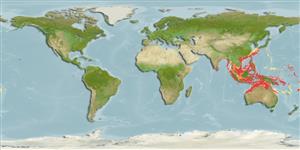>
Eupercaria/misc (Various families in series Eupercaria) >
Priacanthidae (Bigeyes or catalufas)
Etymology: Priacanthus: Greek, prion = saw + Greek, akantha = thorn (Ref. 45335).
More on author: Cuvier.
Environment: milieu / climate zone / depth range / distribution range
Οικολογία
Θαλασσινό(ά) Υφαλόφιλο(α); ωκεανόδρομο(ς) (Ref. 51243); εύρος βάθους 12 - 400 m (Ref. 90102). Subtropical; 32°N - 22°S
Western Pacific: southern Japan to western Indonesia, the Arafura Sea (Ref. 9819), and Australia. Reported from Peter the Great Bay (Ref. 27683).
Μέγεθος / Βάρος / Age
Maturity: Lm ? range ? - ? cm
Max length : 30.0 cm SL αρσενικό/απροσδιόριστο; (Ref. 48635)
Ραχιαίες άκανθες (συνολικά): 10; Μαλακές ραχιαίες ακτίνες (συνολικά): 12-14; Εδρικές άκανθες 3; Μαλακές εδρικές ακτίνες: 13 - 14. Medium-sized fish of moderately deep body. The eyes large; the mouth oblique, with the lower jaw projecting upwards. The body tapers very slightly to beneath the middle of the soft portion of the dorsal fin, and then abruptly to the peduncle. This species is distinguished from P. fitchi by the presence of numerous rusty brown to yellowish spots in the membranes of the dorsal and anal fins, and its less tapered body.
Occurs in inshore and offshore reefs from less than 20 m to more than 400 m depths. Apparently forms aggregations in open bottom areas and is very abundant in the South China Sea and Andaman Sea. Marketed fresh, whole. Sound production has been studied in this species. Also found under ledges or hovering next to coral heads during day (Ref 90102).
Life cycle and mating behavior
Γεννητική Ωρίμανση | Αναπαραγωγή | Γεννοβολία | Αβγά | Γονιμότητα | Προνύμφες
Starnes, W.C., 1988. Revision, phylogeny and biogeographic comments on the circumtropical marine percoid fish family Priacanthidae. Bull. Mar. Sci. 43(2):117-203. (Ref. 5403)
IUCN Red List Status (Ref. 130435)
Threat to humans
Harmless
Human uses
αλιεία: Εμπορικό(ά)
Περισσότερες πληροφορίες
Κοινά ονόματαΣυνώνυμαΜεταβολισμόςΘηρευτέςΟικοτοξικολογίαΑναπαραγωγήΓεννητική ΩρίμανσηΓεννοβολίαΣυναθροίσεις γεννοβολίαςΓονιμότηταΑβγάEgg development
ΑναφορέςΥδατοκαλλιέργειεςΠροφίλ υδατοκαλλιέργειαςΣτελέχοιΓενετικήElectrophoresesΚληρονομικότηταΑσθένειεςΜεταποίησηNutrientsMass conversion
ΣυνεργάτεςΦωτογραφίεςStamps, Coins Misc.ΉχοιΣιγκουατέραΤαχύτηταΚολυμβητικός ΤύποςΕπιφάνεια βραγχίωνOtolithsΕγκέφαλοιΌραση
Εργαλεία
Special reports
Download XML
Διαδικτυακές πηγές
Estimates based on models
Preferred temperature (Ref.
123201): 16.9 - 28, mean 24.4 °C (based on 682 cells).
Phylogenetic diversity index (Ref.
82804): PD
50 = 0.5002 [Uniqueness, from 0.5 = low to 2.0 = high].
Bayesian length-weight: a=0.01622 (0.01239 - 0.02122), b=2.91 (2.84 - 2.98), in cm total length, based on LWR estimates for this species (Ref.
93245).
Τροφικό Επίπεδο (Ref.
69278): 4.1 ±0.60 se; based on food items.
Generation time: 1.5 (1.1 - 2.2) years. Estimated as median ln(3)/K based on 15
growth studies.
Ελαστικότητα (Ref.
120179): Μεσαίο(α), ελάχιστος χρόνος για διπλασιασμό πληθυσμού 1,4 - 4,4 έτη (K=0.7-1.0; tmax=6).
Prior r = 0.32, 95% CL = 0.21 - 0.48, Based on 1 stock assessment.
Fishing Vulnerability (Ref.
59153): Low vulnerability (18 of 100).
Climate Vulnerability (Ref.
125649): High vulnerability (63 of 100).
Nutrients (Ref.
124155): Calcium = 42.3 [23.6, 84.7] mg/100g; Iron = 0.931 [0.514, 1.629] mg/100g; Protein = 20 [19, 21] %; Omega3 = 0.298 [0.158, 0.546] g/100g; Selenium = 28.8 [13.0, 59.1] μg/100g; VitaminA = 42.2 [14.1, 133.0] μg/100g; Zinc = 0.722 [0.458, 1.100] mg/100g (wet weight); based on
nutrient studies.
